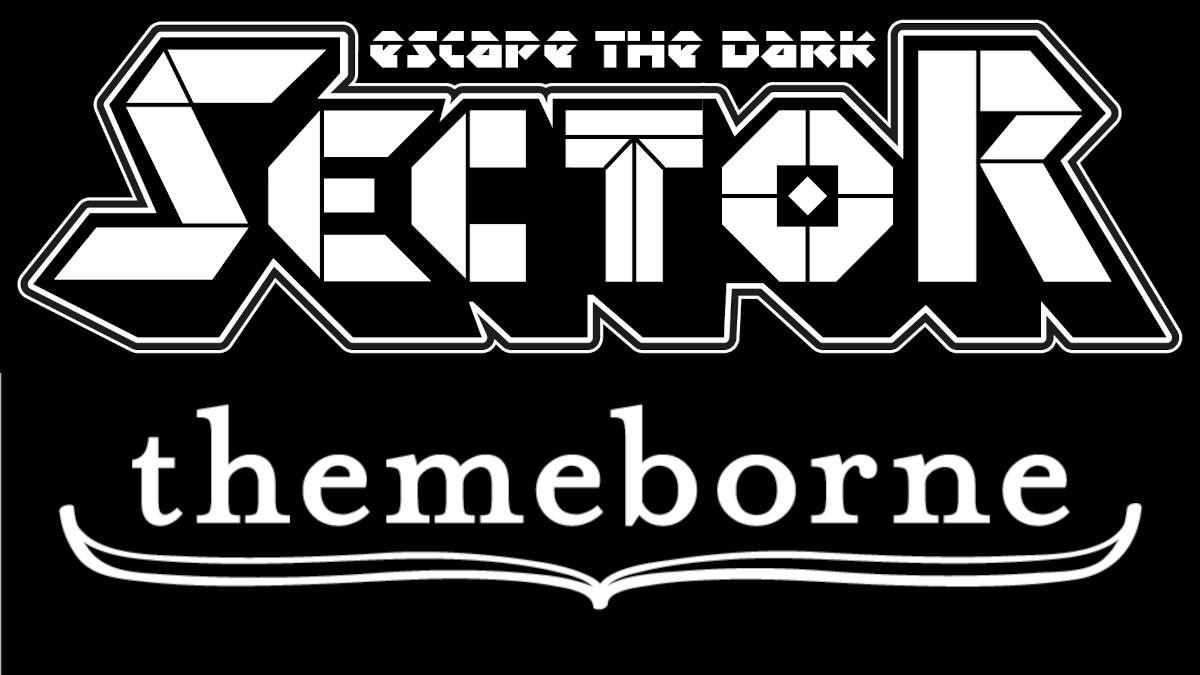
If you were already a fan of Themeborne’s dungeon crawl tabletop game, Escape the Dark Castle, their new Escape the Dark Sector will have plenty of familiar gameplay plus some brand new game mechanics, all set in a gritty, sci-fi theme. If it is all new to you, don’t worry about it; you don’t need to know anything about the previous game to enjoy this one!
Escape the Dark Castle is still one of my favorite tabletop games, and I have previously reviewed a set of expansions to that game.
In this review, I will take care to mention some similarities and differences from the earlier game, but I will try not to be too heavy handed with that, in case you are reading this without that as your background.
What Is Escape the Dark Sector?
Escape the Dark Sector is a card and dice game inspired by old-school role-playing games and ’80s sci-fi books and movies. You and your fellow players are a space ship crew trying to escape the detention block of a space station. You must cooperate to get past guards, avoid hazards, defeat aliens and other horrors; you will all escape, or all fail together.
The game is broken into three acts of four chapters, each act representing a region of the space station. Four chapter cards are randomly selected from a set of sixteen for each act. There are three different starting cards that define how the adventure starts, and five different boss chapter cards that provide different endings. This allows for a lot of variation in repeat game play, and no two games will be alike.
In Act 1 the crew starts out on the detention level, and must survive four chapter cards that describe challenges such as guard patrols, laser grids, or foul smelling ventilation ducts. Act 2 brings the crew to heart of the station, where they may encounter laboratories of experimental technology, corridors covered in glistening alien tissue, alien mercenaries, or cyborg vision-sellers. If the crew survives that, they reach The Forgotten Zones in Act 3, where monstrous aliens roam, rooms may have explosive booby-traps, ruthless bounty hunters hunt for the crew, and dangerously malfunctioning robots are slaughtering anyone they encounter. If the crew manages to clear all twelve levels, they must then defeat a boss challenge such as Sgt. Steel, The Entity, or The Alien Queen. This is a cooperative game, if at any point a player dies, everyone fails!
This three act breakdown is different from the earlier Escape the Dark Castle game, which had fifteen chapter cards randomly selected from the deck. I really like this new three-act approach, which really helps build a sense of plot moving forward against mounting challenges as the crew tries to reach their ship and escape.
The game is easy to set up and takes about 45 minutes to play with 2 to 4 players. There are some alternate rules for solo play, if desired. Every player will be involved with every round of action, and must coordinate their efforts to win. I’d recommend this game for players aged 10 and up. My 13-year-old daughter and 16-year-old son both enjoyed it, as well as my adult friends.
Escape the Dark Sector was created by UK game design studio Themeborne. They launched the game on Kickstarter in May 2020, and began general availability in September.
Escape the Dark Sector Components
The game is printed on quality card stock, and the box and rule book are all nice quality too. The black and white artwork is purposefully reminiscent of old-school role playing game drawings. The special game dice are gorgeous, and a pleasure to play with.
Component List
- 3 Start Cards
- 16 Act 1 Chapter Cards
- 16 Act 2 Chapter Cards
- 16 Act 3 Chapter Cards
- 5 Boss Cards
- 6 Crew Character Cards
- 4 Starting Weapon Cards
- 6 Starting Cybernetics Cards
- 24 Item Cards
- 2 Tactical Action Cards
- 6 Crew Dice
- 9 Chapter Dice
- 7 Ballistic Ammo Dice
- 7 Energy Ammo Dice
- 2 Explosive Ammo Dice
- 4 Hit Dice
- 1 Rule Book
- 2 Rules Reference Cards
- 1 Medical Report Pad
- 4 Pencils
- 2 Epilogue Cards

Characters
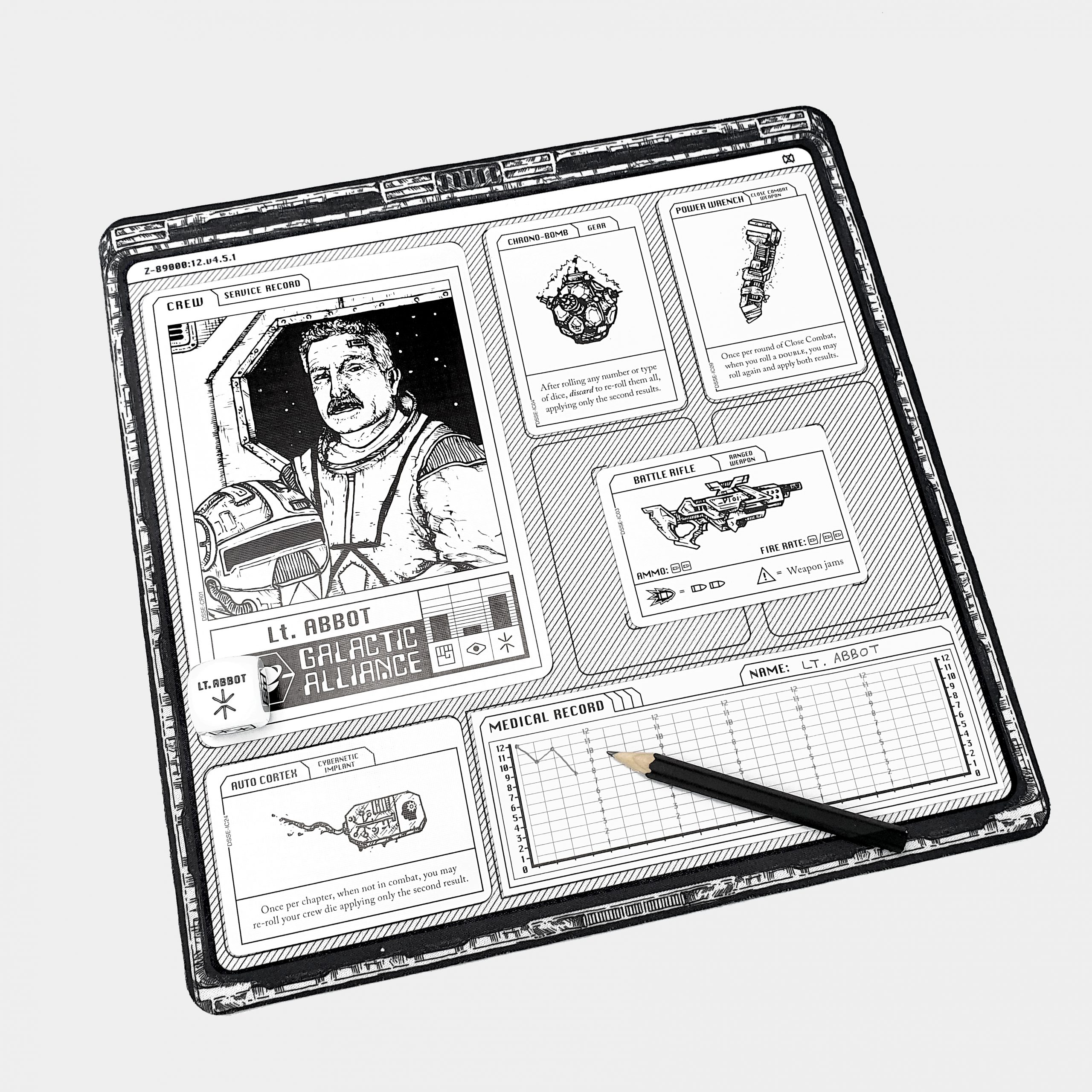
Each player controls a unique character in the game, each a member of the ship’s crew with different attributes. The game’s simple character system defines 3 attributes: wisdom (represented by an asterisk), cunning (represented by an eye), and might (represented by a fist). For example, the Lt. Cook’s strongest attribute is might, while Lt. Tailor is more wise. Each character has a unique white character die that reflects their attributes. The character’s top attribute will be more heavily pictured on their character die. A shield symbol on a die face represents the character’s defense, but I’ll explain more about that later.
Fans of the original Escape the Dark Castle may find the names of the crew members humorously familiar (Lt. Cook, Lt. Smith, Lt. Miller, Lt. Tanner, Lt. Tailor, and Lt. Abbot).
Chapters
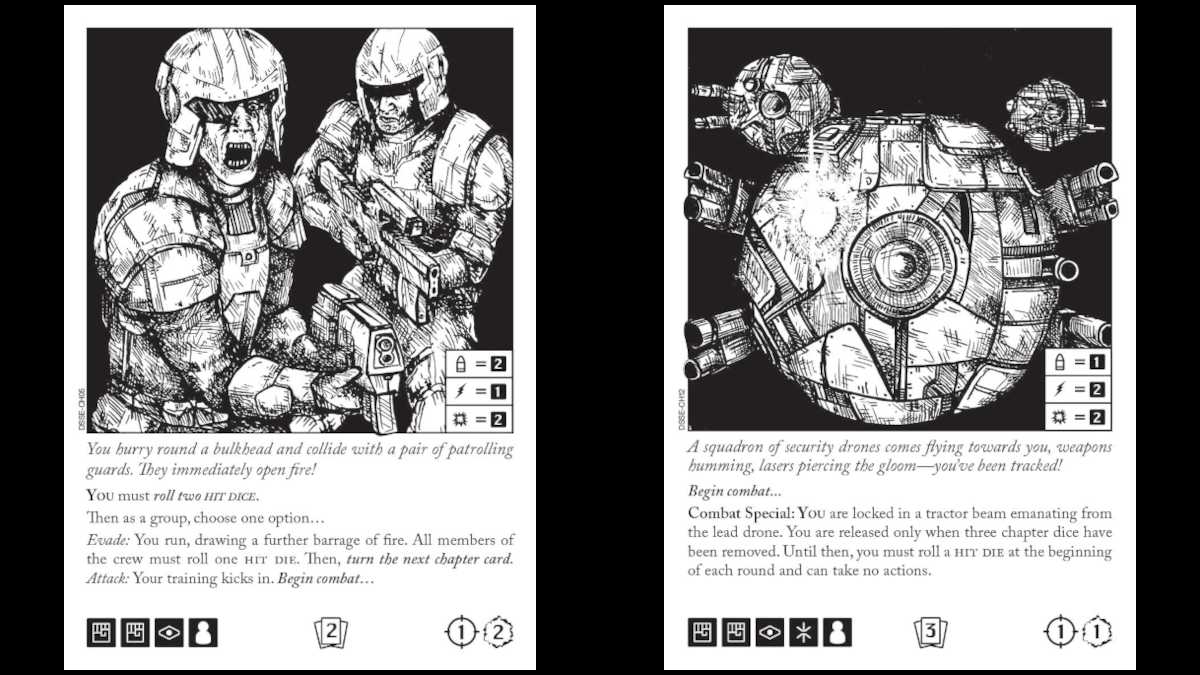
The deck of chapter cards present obstacles the players must overcome. There are guards, robots, aliens, traps, and hazards in the space station. Some of the chapter cards have special instructions that might impact the first character to enter the room, and there are special combat rules for some foes. The challenges on the cards all require different mixes of wisdom, cunning, and might to defeat. With 48 chapter cards in the deck (sixteen for each act), each game of 12 chapters represents a unique set of challenges.

The black chapter dice have an equal mix of wisdom, cunning, and might. However, each chapter card dictates how many chapter dice the players will need to face, as shown in the bottom-left corner of the card. The more chapter dice, the tougher the challenge.
The symbols at the bottom-right of the chapter card indicate how much damage the characters might receive in combat from an enemy. The number in the circular crosshairs symbol is the amount of damage dealt by the enemy in ranged combat. The number in the rough-edged hole symbol is the amount of damage the enemy deals in close combat. More about ranged and close combat rules later.
If the chapter card has a number within a cards icon at the bottom-center of the card, that indicates how many items the players get to pick from the items deck if they successfully meet the challenge of the chapter. As you will see, items are vital your crew surviving!
Items
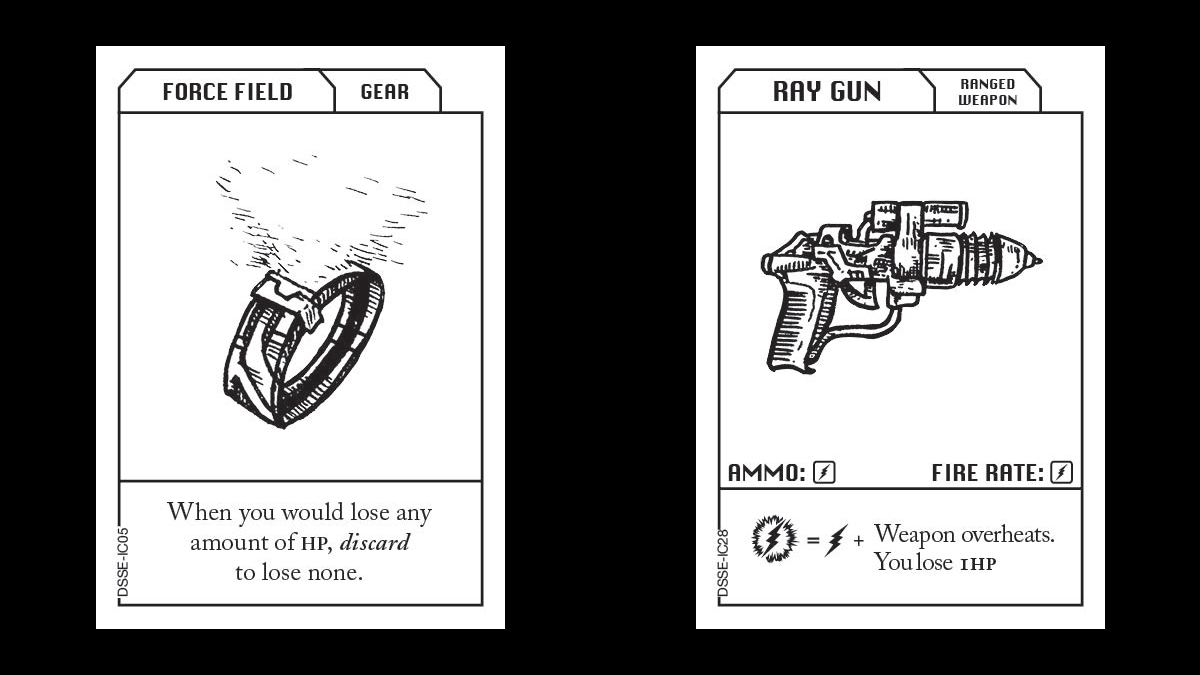
You generally get items after you win in combat, but there are times a chapter card will direct you to draw items for other reasons. Items help your characters survive the space station. Even some stale rations can help you restore a bit of health. Armor, weapons, and other gear, sometimes of alien origin, can help you in a fight. Other items may help you tilt chance in your favor by altering dice rolls.
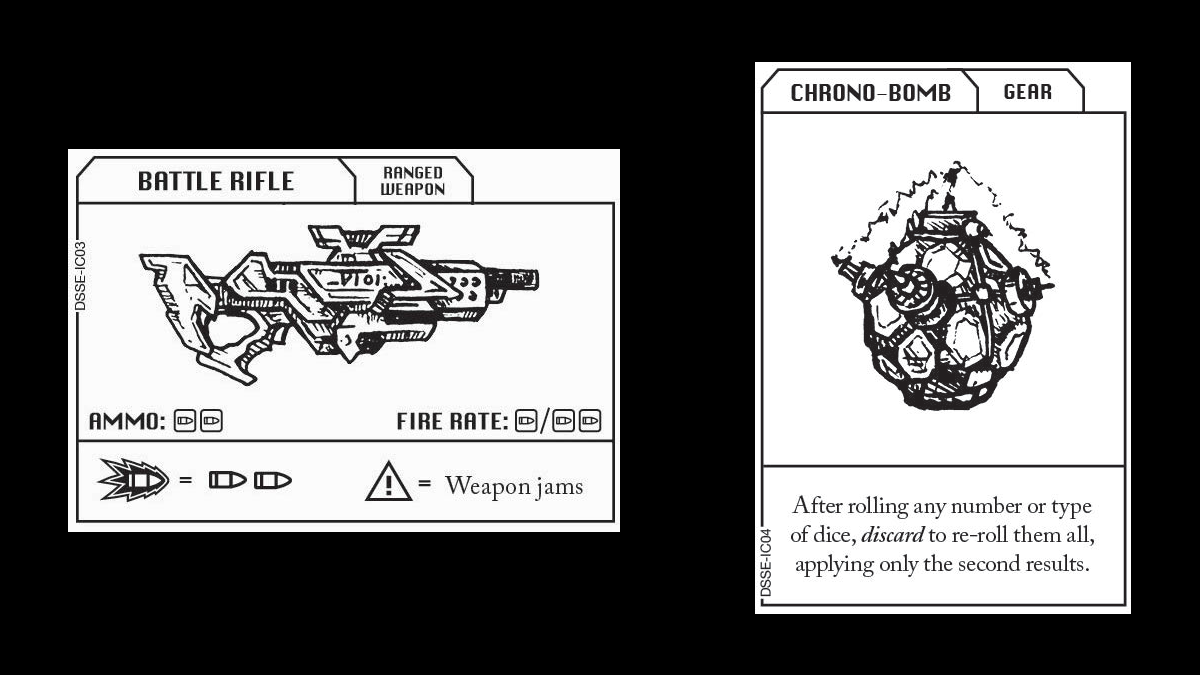
Players can carry up to four items if they are displayed on the item card in portrait orientation. Items displayed in landscape orientation like the Battle Rifle are larger. You can carry up to two larger items, or one larger item along with two smaller ones.
When items are drawn they are placed face up in the playing area. The players then jointly decide how to distribute the items, keeping in mind the limits on how much each crew member can carry. Items can be exchanged only between chapters, after drawing new items, or with the TRADE action during combat. The TRADE action is one of the changes to the combat system introduced in Escape the Dark Sector.
Bosses

If your weary crew manages to clear all the chapters in the game, they still need to face a boss! These opponents are the biggest challenge you will face, so don’t expect an easy finish.
Notice the symbols at the bottom-left of the boss card pictured above. To defeat The Alien Queen, you will face 3 chapter dice with might (the fist), 2 with cunning (the eyeball), plus you will roll the number of chapter dice equal to the number of players. The Alien Queen is harder to hit than most enemies, and you can only hold her at bay with ranged combat for one round… then it is up close and personal! The numeral 3 pictured at the bottom-right of The Alien Queen’s boss card indicates that she does 3 points of damage in close combat. After fighting your way through twelve chapters, will you have enough health left to defeat her?
How to Play Escape the Dark Sector
Set Up
You set up the game by randomly picking one of the five boss cards (no peeking!) and laying it face down. Then you randomly pick four Act 3 cards and place them face down on top of the boss. Next four Act 2 cards, and then four Act 1 cards. Lastly you add one of the three start cards to the top, and you have your randomized mission deck in a face-down stack with the boss card on the bottom of the chapter and start cards, and your adventure is ready to go.

Each player picks a character and takes the corresponding character die. I recommend you try to build your party so that wisdom, cunning, and might are roughly equally represented. Each crew member starts with twelve health points, which they track on their own medical record sheet.
Each crew person also gets a cybernetic implant card, which provides special abilities in either ranged or close combat, or for non-combat situations. Everyone on the crew draws one of the starting weapon cards, to give you some small chance of survival.
You will also arrange the two tactical combat action cards face up in the play area, along with the deck of item cards, and all the chapter, hit, and ammo dice.
Turning Chapter Cards
Decide as a group who will turn each chapter card. The one who flips the card may be affected by what is written on the card more than the rest of the characters. I found it best to rotate this duty, especially as characters become wounded. Remember, if any of you die, you all lose the game.

Each chapter card will have instructions and a challenge of some kind. You’ll have to make choices, use items, and fight terrible foes. As mentioned, some cards will tell you to draw item cards, and you also get to draw item cards if you defeat an enemy.
Drawing and Using Items
When items are drawn, the cards are placed face up. Each character can carry up to four items, depending on size. Just remember that an item printed on a landscape orientation card indicates that it is large and takes up two item spaces instead of one. Items can be used at any time, and some are discarded after use. Items can be redistributed among players at the time they are drawn, or just after a chapter has been completed. You can only trade items during combat by using the TRADE action, which is described in the Combat section below.
Combat
Probably the biggest change in this game from Escape the Dark Castle is the combat system. Close Combat is nearly identical to what players of that previous game are used to, although there are some new actions available. The big change is the addition of Ranged Combat, which complicates gameplay a little bit, but overall is a real enhancement.
When a chapter card directs you to begin combat, the players generally have a choice of ranged or close combat. All players decide together, and all will follow the rules for the type of combat chosen. Some chapter cards will specifically direct you to begin Close Combat or begin Ranged Combat, and then you don’t get a choice. However, once close combat begins, you cannot to back to ranged combat… the enemy is right on top of you!
Ranged Combat
Ranged combat assumes all crew members dive for cover and are temporarily safe from attack. However, the primary action you can take in ranged combat is to shoot, which will expose you to return fire. Your crew member needs a ranged weapon loaded with ammo in order to shoot. There are ballistic, energy, and explosive weapons.
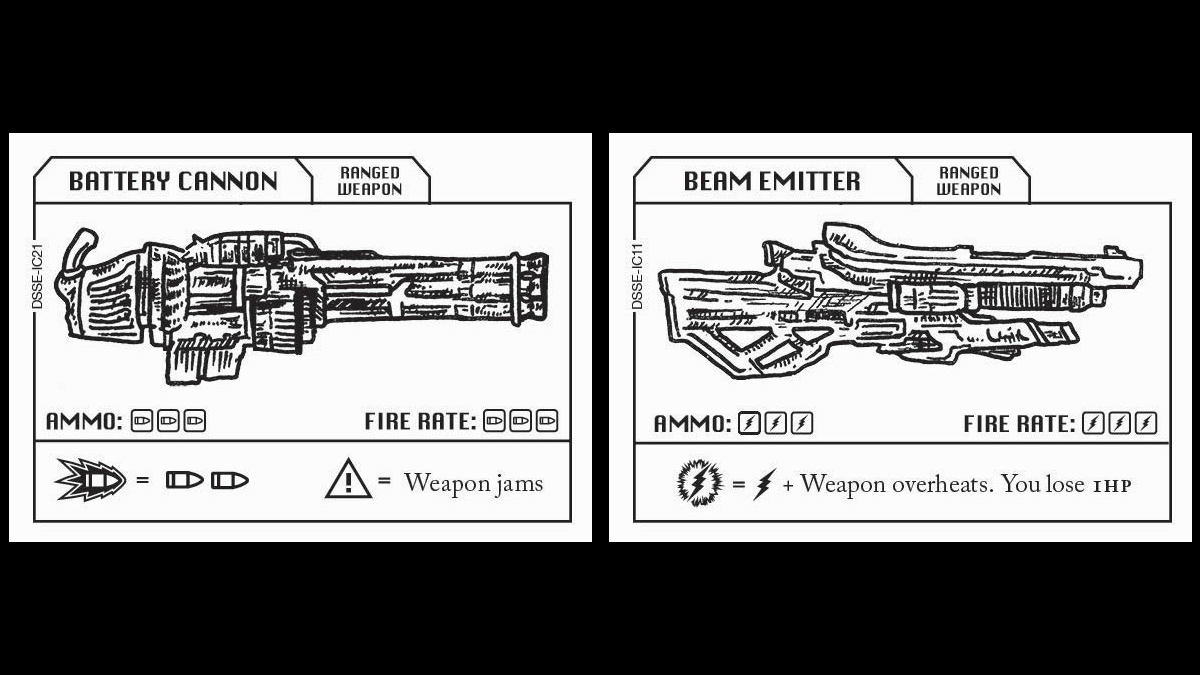
The weapon’s item card lists the ammo type/capacity, as well as the fire rate. Weapons you find are fully loaded, but you will need to spend actions to reload after firing them. The item card will also include info at the bottom about what happens if a ballistic weapon jams or a grenade is a dud, plus special effects that may be good or bad depending on the weapon.
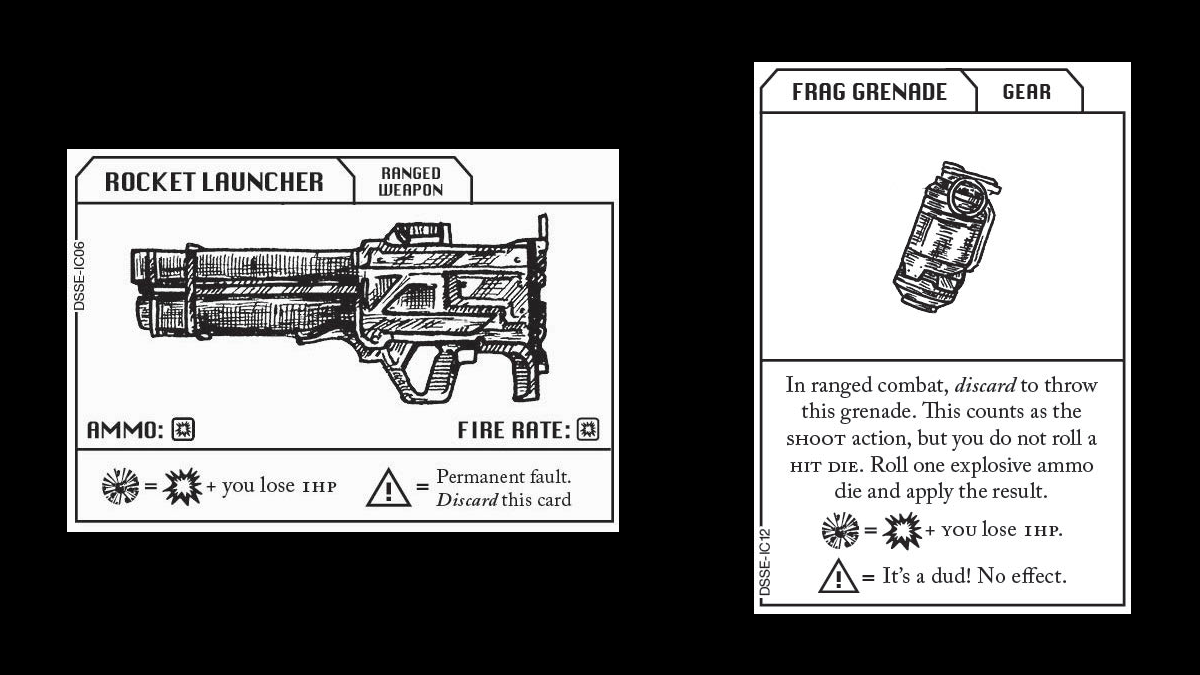
As part of ranged combat, there are three types of ammo dice: Ballistic, Energy, and Explosive, which each correspond to the different weapon types. Ballistic dice have a bullet symbol on three sides indicating a single hit, a blank side indicating a miss, an exclamation mark in a triangle indicating a weapon jam, and a special effect symbol (usually indicating a double-hit in a ballistic weapon). Energy dice are similar to ballistic, but with four sides having a lightning bolt that indicates one energy hit, a blank indicating a miss, or a special effect that is usually bad (e.g., your weapon overheats and you lose one health point). Explosive dice are used for grenades and such. The Explosive dice have blast symbols on three sides indicating a hit, a blank side indicating a miss, an exclamation mark in a triangle indicating a dud, or a special effect explosion symbol, which may mean a hit but you also get caught in the blast and lose some health points.

When you attack in ranged combat, you also roll a black hit die, which which shows a crosshairs symbol on four sides and two blanks. This represents the enemy’s return fire. If you are hit, you will lose the number of health points indicated on your opponent’s chapter card in the crosshairs at the bottom-right.
To take the shoot action during ranged combat, you roll the number and type of ammo dice based on your weapon’s fire rate, plus one black hit die. Next you apply the effect of your shot based on your opponent’s chapter card. Some enemies are more vulnerable to one type of ammo than another. Finally, you apply the enemy’s return fire by evaluating the hit dice, and apply the damage based on the number in the crosshairs at the bottom-right of the enemy’s chapter card.
Instead of shooting, one crew member choose to try a flanking action. This can only be done once per chapter, but it sets that crew member up for an extra flank round where they alone get to attack and they get special bonuses. During a flank attack the crew member may chose another ranged attack or a close combat attack. If they choose close combat the remainder of the fight for this enemy will all be close combat.
Close Combat
As mentioned, once close combat begins your crew cannot go back to ranged combat for this chapter. The primary action available is to fight.
Each foe you fight will have a set of dice icons on the lower-left corner of their card. This represents the number of chapter dice the players face. The icon with the person symbol indicates that you will roll the number of chapter dice equal to the number of players and add them to the other chapter dice shown on the chapter card.
Players get to attack first, by simultaneously rolling their character dice. Each symbol shown on the players’ dice takes away an equal number of chapter dice with the same symbol. Some character dice have 2 symbols on a face instead of one, which means you can take away 2 chapter dice with the matching symbol. For example, Lt. Smith’s die has 2 might symbols on 1 side, and 2 wisdom symbols on another. The double-symbol faces of the dice also picture a shield, which you use for defense.
If you fail to defeat your enemy in the first round, they get to attack the party. Any player who rolled a shield symbol does not take damage that round. Everyone else takes the amount of damage shown on the chapter card’s lower-right corner in symbol that looks like a ragged hole with a number in it.
This is where items can help avoid damage or heal back lost health points. Remember items can be used at any time, but can only be traded after the chapter is completed unless a player uses the trade action instead of fighting.
As with ranged combat, each round of close combat one player can elect to activate the medical drone instead of fighting. They take no damage that round and gain back one health point, and only one player can rest during each round. Other actions available during ranged combat are to reload, trade to take one item from another player (as long as they are not using it), take cover and therefore stay safe from enemy fire, or activate the medical drone to gain back one health point (only one crew member per round of combat can use the medical drone).
Standard Combat Actions and Ending Combat
Other actions available during either ranged or close combat are to reload, trade to take one item from another player (as long as they are not using it), take cover and therefore stay safe from enemy attack, or activate the medical drone to gain back one health point (only one crew member per round of combat can use the medical drone).
Combat continues round after round until either the enemy is dead, or one of the characters dies and the game is lost. If you defeat your foe, the party gets to draw the number of item cards listed at the bottom of the enemy’s chapter card. This is a good time to trade items, before you draw the next chapter.
Will I Enjoy Playing Escape the Dark Sector?
Gamers who like cooperative games with lightweight rules should enjoy Escape the Dark Sector. The cooperative play provides a good balance between luck and tactics. I also found the game to be well balanced; expect to lose almost as often as you win. The game is always a challenge, and victory is never assured.
Although gameplay is relatively simple compared to many games, players familiar with Escape the Dark Castle will find the new combat system a tiny bit more complex than the old. On the whole, I felt it enhanced the game, and was well-worth the extra rules.
Gameplay is enhanced if you take the designers’ advice and read all the italic text aloud. So feel free to ham it up and create an atmosphere of dystopian sci-fi foreboding. Speak and act as your character would if you want to. The storytelling aspect of the game is half the fun. If you have fond memories of role-playing games, but don’t want to invest the time, this game provides some of that flavor.
The large number of chapter cards, multiple boss cards and starting cards, and mixing up which crew member you play with which cybernetic implant means this game has lots of replay value.
If you prefer heavy strategy games, or don’t like games where chance is a big factor, you might want to look elsewhere. Very young players who don’t react well to losing may not enjoy this game, although the cooperative nature of the game means at least they are not losing to the other players.
On the whole, I’d recommend Escape the Dark Sector, especially if you enjoy old school sci-fi. You can order the game on Themeborne’s web shop.



